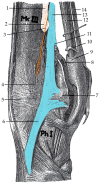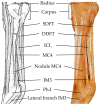A Primitive Trait in Two Breeds of Equus Caballus Revealed by Comparative Anatomy of the Distal Limb
- PMID: 31197123
- PMCID: PMC6617308
- DOI: 10.3390/ani9060355
A Primitive Trait in Two Breeds of Equus Caballus Revealed by Comparative Anatomy of the Distal Limb
Abstract
The 55-million-year history of equine phylogeny has been well-documented from the skeletal record; however, this is less true for the soft tissue structures that are now vestigial in modern horse. A recent study reported that two ligamentous structures resembling functional interosseous muscle II and IV were evident in Dutch Konik horses. The current study investigates this finding and compares it to members of the genus Equus to identify either a breed anomaly or functional primitive trait. Distal limbs (n = 574) were dissected from four species of Equus; E. caballus, E. asinus, E. przewalskii and E. quagga boehmi. E. caballus is represented by 18 breeds of horse, including the primitive Dutch Konik'. The interosseous muscle II and IV were evident in all four species, but only two breeds of E. caballus expressed this trait-the Dutch Konik and Bosnian Mountain Horse. These two breeds were the only close descendants of the extinct Equus ferus ferus (Tarpan) represented in this study. In conclusion, the interosseous muscle II and IV originated from the distal nodule of metacarpal II and IV, respectively, and inserted into the corresponding branches of interosseous muscle III proximal to the sesamoids. This suggests a functional role in medial and lateral joint stability and a primitive trait in modern equids.
Keywords: Atavism; Bosnian Mountain Horse; Donkey; Dutch Konik; III and IV; Przewalski’s horse; Zebra; interosseous muscle II.
Conflict of interest statement
The authors declare no conflict of interest.
Figures




Similar articles
-
The Disappearing Lamellae: Implications of New Findings in the Family Equidae Suggest the Loss of Nuchal Ligament Lamellae on C6 and C7 Occurred After Domestication.J Equine Vet Sci. 2018 Sep;68:108-114. doi: 10.1016/j.jevs.2018.03.015. Epub 2018 Mar 29. J Equine Vet Sci. 2018. PMID: 31256881
-
Recalibrating Equus evolution using the genome sequence of an early Middle Pleistocene horse.Nature. 2013 Jul 4;499(7456):74-8. doi: 10.1038/nature12323. Epub 2013 Jun 26. Nature. 2013. PMID: 23803765
-
Rare Finding of a Full Nuchal Ligament Lamellae With Attachment Points From C2-C7 in One Australian Stock Horse.J Equine Vet Sci. 2020 Jan;84:102847. doi: 10.1016/j.jevs.2019.102847. Epub 2019 Nov 14. J Equine Vet Sci. 2020. PMID: 31864465
-
Gastrointestinal Parasitism in Przewalski Horses (Equus ferus przewalskii).Acta Parasitol. 2021 Dec;66(4):1095-1101. doi: 10.1007/s11686-021-00391-7. Epub 2021 Apr 22. Acta Parasitol. 2021. PMID: 33886041 Review.
-
Parasitic fauna of Polish konik horses (Equus caballus gmelini Antonius) and their impact on breeding: a review.Anim Health Res Rev. 2018 Dec;19(2):162-165. doi: 10.1017/S1466252318000099. Anim Health Res Rev. 2018. PMID: 30683169 Review.
Cited by
-
An Update on Status and Conservation of the Przewalski's Horse (Equus ferus przewalskii): Captive Breeding and Reintroduction Projects.Animals (Basel). 2022 Nov 15;12(22):3158. doi: 10.3390/ani12223158. Animals (Basel). 2022. PMID: 36428386 Free PMC article. Review.
References
-
- Darwin C. On the Origin of Species. John Murray; London, UK: 1859.
-
- Rogers G. Brother Surgeons. Random House; London, UK: 1957.
-
- Thomson K.S. Huxley, Wilberforce and the Oxford Museum. Am. Sci. 2000;88:210–213. doi: 10.1511/2000.23.3371. - DOI
Grants and funding
LinkOut - more resources
Full Text Sources

